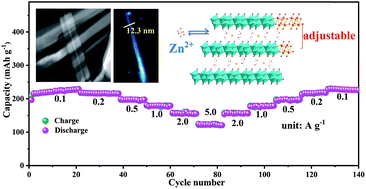Highly reversible and long-life cycling aqueous zinc-ion battery based on ultrathin (NH4)2V10O25·8H2O nanobelts†
Abstract
Zinc-ion batteries (ZIBs) as an alternative to Li-ion batteries and lead-acid batteries possess many advantages, such as environmental friendliness, safety, and cost effectiveness. Many materials have been used as zinc-ion cathode materials. Yet, the critical technology about the relationship between a material’s structure and the zinc storage performance is unclear and challenging. Herein, ultrathin (NH4)2V10O25·8H2O nanobelts were first demonstrated as a cathode material for ZIBs. The nanobelts have an interlayer spacing of 1.045 nm in the c-axis direction which is adjustable between 1.045 to 1.32 nm without structural damage during a facile Zn2+ insertion/extraction. The unique ultrathin and stable structure complemented by the large lamellar spacing enables a high Zn2+ diffusion. As a result, the (NH4)2V10O25·8H2O/Zn cell demonstrates a high rate capacity and a high specific energy of 225.4 W h kg−1 and satisfactory cyclability (capacity retention of 90.1% after 5000 cycles). Our result provides a feasible and attractive solution for synthetic cathode materials for aqueous ZIBs.



 Please wait while we load your content...
Please wait while we load your content...